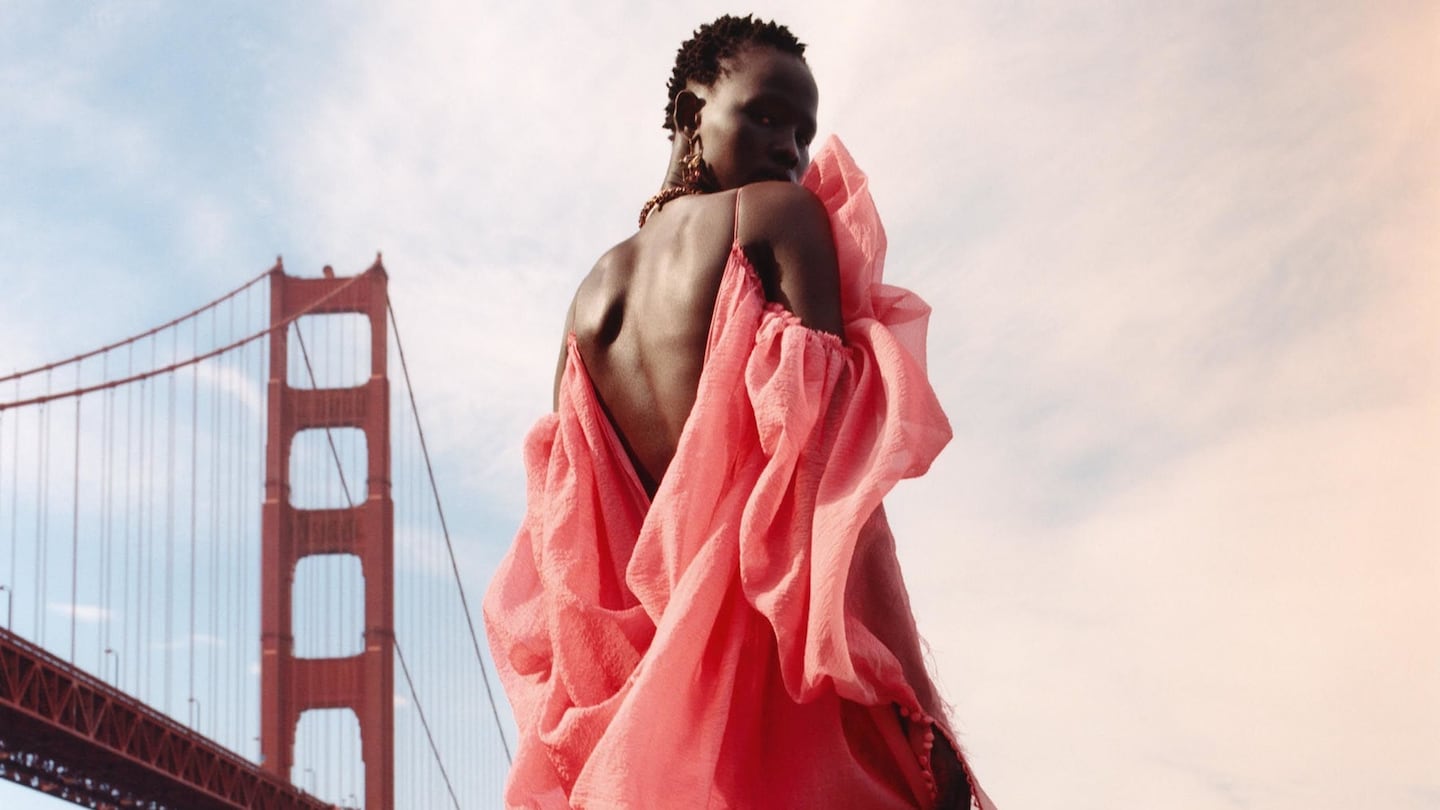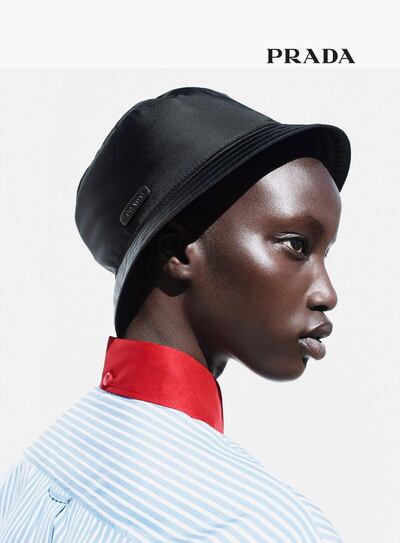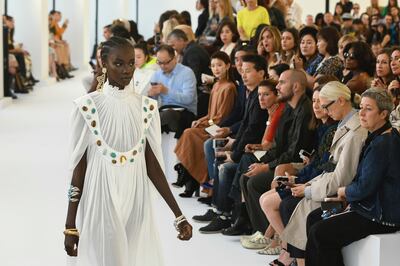
The Business of Fashion
Agenda-setting intelligence, analysis and advice for the global fashion community.

Agenda-setting intelligence, analysis and advice for the global fashion community.

JUBA, South Sudan — When Shanelle Nyasiase moved from her native South Sudan to Nairobi, Kenya to live with her 12 cousins, she had no idea she would soon be closing the Balenciaga runway show or appearing in ad campaigns for the likes of Versace and Alexander McQueen.
Soon after taking local modelling jobs to support herself, Nyasiase was introduced to photographer Daniele Tamagni who then connected her to “mother agent” Ingrid Tamborin, and things began moving quickly.
“Her career was fast,” says Tamborin, who is based in Milan but travels to Kenya, Ethiopia and the East Africa region to find talent, managing around 10 girls at a time. “It has a lot to do with uniqueness: she’s strong and clever, with good instinct. [At the time] she wasn’t the Shanelle you know now.”
The Shanelle that she first met was shy and scared to travel abroad, but as her “mother agent,” it was Tamborin’s job to develop her, send her to test shoots and eventually get her to sign on to modelling agencies in Europe and the US like MP, Red Models and Storm Management. During her first season, Nyasiase walked 43 shows and featured in editorials for American Vogue, Dazed and i-D. Today, she spends only two months in Nairobi, travelling for jobs throughout the remainder of the year.
ADVERTISEMENT

“If you don’t have the right mother agent, it can mess you up,” said Nyasiase. “There’s a lot of new faces from Africa, and the advice I give them is to have the right people and approach the right mother agency. Ingrid cares for me like a mother.”
Nyasiase's star is on the rise at an interesting time, one that BoF editor-at-large Tim Blanks has dubbed "the season of the black model." The latest wave of talent from Nigeria, South Sudan and Angola has emerged as a result of the developing network between mother agencies and scouts, like Tamborin, who travel to remote towns and villages in search of the next "It"-girl.
Modelling has traditionally gone through waves — at any given point, the most in-demand faces were Russian, Brazilian, Dutch or Nordic, making up a sizeable proportion of runways.
African talent, however, was outnumbered. In the 1980s, 1990s and 2000s, models like Iman (from Somalia), Alek Wek (South Sudan) and Oluchi Onweagba (Nigeria) were exceptions, rather than the rule. It didn't help that mother agents were few and far between, meaning the number of models scouted was rare. But in the past two to three years the industry's push for diversity has begun to pay dividends. "Things are opening up this year," says Tamborin. "Three years ago, you could count on one hand the number of African models internationally."
"Designers are more receptive to the fact you can have dark, dark skin and still be beautiful," says Jason Valenta, director of scouting at Next Models, which has signed on emerging talent such as Anok Yai (Egyptian-born of Sudanese heritage) and Oumie Jammeh (born in Gambia), along with established faces like Lineisy Montero.
While mixed-race or lighter-skin models like Montero, who hails from the Dominican Republic in the Caribbean, have always been present, he says darker skinned models have never been as in demand as they are today, and cites mother agents in emerging markets as catalysts for this movement.
If you don't have the right mother agent, it can mess you up.
Yai — who was famously discovered through Instagram and who Valenta "called every day for 3 weeks" before signing her on — opened the Prada Autumn 2018 show, the first black model to do so since 1997. Adut Akech (born in South Sudan, raised in Kenya and Australia) closed Chanel's latest haute couture show as the bride, making her the second black "Chanel bride" in history. Overall, models of colour made up 44.8 percent of runway castings this season in New York — the highest-ever number.
It is the fashion industry's increased push for diversity and widening definitions of beauty that "put far-flung places around the world on the radar," Valenta says. Emerging markets, and their respective mother agencies, have been put in the spotlight for "supplying incredible talent into the mainstream international market," says Simon Chambers, founder of Storm Models, the UK-based agency that discovered Kate Moss and Cara Delevingne, among others.
ADVERTISEMENT
Diversity on the runways may now finally be within reach, but many of today’s reputable mother agencies were established over a decade ago, sourcing talent for the local fashion industries and, on occasion, internationally.
“We’ve been in business for 15 years [but] scouting in Nigeria is more intense now, and we’ve seen the number of models grow,” says Elizabeth Elohor, founder of Lagos-based Beth Models. Mayowa Nicholas, who was on her way to the hair salon when Elohor spotted her, adds that when she started, “I don’t think there was any Nigerian model in the industry — it’s nice to have so many now.”
Alongside Cape Town and Johannesburg, Lagos and Nairobi are two capitals of the African fashion industry, a fact which accounts for the large number of Nigerian and Kenyan faces. South Sudanese models typically join the industry through agencies in Nairobi, explains Tamborin. A mere 90-minute flight away, South Sudan’s relatively sleepy capital Juba doesn’t yet boast a local mother agency of its own, or a developed fashion industry.

Many Nigerian models got their start at Lagos Fashion Week, a multi-day fashion event showcasing local designers. “Before models go anywhere, we’ve worked with them,” says founder Omoyemi Akerele, who remembers Oluchi Onweagba and Mayowa walking for Nigerian designers before making it internationally.
Part of what makes the event a good incubator for talent is Akerele’s pact to work only with local models, rather than flying in famous faces from abroad. This type of support means, once they make it internationally, “they’re open to come back and walk here [again].”
For a mother agency to break into the international market and seek a slice of the multi-million dollar modelling industry, finding one girl who “makes it” can sometimes be enough. Bolajo Fawehinmi is the founder of Lagos-based Few Models, and scouted Eniola, Ayobami and Olamide. (Eniola signed with next, while Ayobami and Olamide signed with IMG. All three girls walked in numerous shows last season.)
“All you need is one model to convince the masthead that they are great,” she says, adding that the success of one star can help financially support a mother agency for years to come.
“Mother agencies have become more determined [now],” says Akerele, pointing to recent partnerships between mother agencies and international ones. The Few Next Face Africa event resulted from a collaboration between Few and IMG, while Beth Models and Elite partnered on the Elite Model Look Nigeria competition.
ADVERTISEMENT
“Beth Models [has] consistently raised the bar with [its] army of scouts, working tirelessly to discover and nurture new models across Africa,” says Akerele. “It’s no wonder that some of the models are gradually becoming some of fashion’s most sought-after new faces today.”
For many leading model agencies in Europe and the US, mother agents in emerging markets have now become essential to secure the right mix of talent. "Some mother agencies really work as managers, and have incredible relationships with their talent," says Chris Gay, co-chief executive of Elite World, which also includes Supreme and The Society.

At Elite, “it comes down to the [mother agent’s] reputation,” says Gay. “If someone feels they have potential, one of our offices is informed, and they start tracking progress.” In some cases, agencies are informed of a potential model as soon as she signs with the mother agent — others prefer to wait.
However, some mother agencies mismanage models. Others can be downright abusive. Due to poor regulation in some developing countries, engaging in unethical behaviour, including sending vulnerable underage talent to a foreign market without a guardian or chaperone, is not uncommon. Recently, Romanian model Andreea Diaconu recalled her early modelling days in an interview for Vogue magazine, citing situations where she was asked to go topless at 14, or told by a booker to “socialise and go to clubs” to further her career.
At the other end of the spectrum, some of the better mother agencies have taken on the role of protector and mentor. This is certainly the case for Mark Luburic and Gunita Stobe, founders of Mumbai-based Anima Creative Management, India’s leading mother agency. “We take a hands-on [approach to] development,” Luburic says. “Our role is to support and coordinate between agencies, make decisions where girls have to go. We have WhatsApp groups with every girl.”
Constant communication is paramount, agrees Pooja Mor, one of India's best-known faces. Moor was discovered by Luburic and Stobe and has appeared on the covers of Vogue Italia and Vogue Arabia. "I tell girls to go and look for a mother agency, because there's no point in doing it yourself," she says. "They root for me."
Mother agents can sometimes take on a more literal approach, becoming maternal figures for models — especially those who haven’t travelled abroad before. Few Models’ Fawehinmi needs to protect the “interests” of her girls, otherwise “you’re exposing girls to people making decisions that aren’t necessarily best for them.”
Scouting a girl at the age of 13 or 14, and developing her for a couple of years, was normal practice until the fashion industry's so-called "year of reckoning," which culminated in Condé Nast's code of conduct, Kering and LVMH's model charter and The Model Alliance's Child Model Act in New York. Signing on girls under the age of 18 is now frowned upon, not to mention illegal in New York if a company does not possess a certificate of eligibility, submit advance notice, make sure child models have valid work permits and adhere to restricted working hours.
A good mother agent will support a model from her early days onwards, and earn 10 percent commission on every job she books.
As a result, some mother agencies have been forced to change models’ timelines of development. “Before, [we scouted a girl] at the age of 14, and in two years she would go international,” says Beth Models’ Elohor. “Now we’ve started scouting girls at 16, because we don’t want to keep them for so long — they tend to lose focus.”
Before signing with an agency in one of the big four fashion capitals, models will be sent for test shoots and runways in their home markets, or to Asia, where commercial opportunities are greater. For Avant's Shavrina, Spain has also become a good spot to send models because "companies like Inditex will use three girls per day for brands like Zara, and it's a great market to earn money and develop talent."
Shavrina takes on a more proactive approach than the rest: her agency hosts "Avant Camp." Call it a two-week crash-course on modelling, with everything from cooking and walking to dance classes being taught. It was at this camp that Kris Grikaite was booked for a year-long Prada exclusive in June 2016. "We host it because girls should be ready — competition is high, and clients don't [always] pay so much," Shavrina says.
Often, a good mother agent will support a model from her early days onwards, and earn 10 percent commission on every job she books for years to come, meaning they often take a long-term view of a career. “It’s important for us to know what’s going on,” says Nik Lavrov, managing director at Moscow-based mother agency Number Management, which counts a number of emerging faces from Russia on its main board. “[So much so that] we’d like to have veto power.”
Ten percent of every model’s job for the rest of her career can make or break a mother agency, especially for a sought-after model. According to the Bureau of Labour Statistics, models in New York only earn on average $48,130. But those in the top league can command eye-watering sums.

Few Models’ Fawehinmi expects annual gross earnings at her agency to exceed $5 million in 2019, with some of the models in her books earning upwards of $2 million a year (a staggering income in Nigeria).
However, being a top editorial or catwalk model is not necessary guarantee of being a top earner. “A girl who isn’t famous but is doing catalogues could make $250,000 a year, but someone on every single catwalk can earn [just] $10,000 a year,” says Esther Kinnear Derungs, co-founder of London-based mother agency Linden Staub.
“If you’re an agent and your goal is to book as much as possible, you need to have the best girls.” In order to do that, agents will exchange girls or place a model in an agency in return for someone better. “It’s a money exercise.”
Critics of the highly transactional and disposable nature of the industry are quick to point out that while many young models are lured into the trade by a rag-to-riches story of a famous predecessor, success is by no means guaranteed. In fact, the vast majority of girls scouted by mother agencies in the developing world never make it this big, and some will return home empty handed.
Yet, for the lucky few who do make it big, the opportunities can be even greater than personal fame and fortune. Scouts and mother agents are aware that spotting a girl in an impoverished village and developing her into an It-girl can bring modest but meaningful economic benefits back to a model’s home country. Often, there is a spike in interest in models from that country and the global fashion industry’s appetite for muses from that part of the world often increases.
“When you have a model from a [remote] emerging market, you’re opening up that [whole country] to the international fashion [industry],” says Tamborin. So by using her platform as a model, “she [can become] an ambassador [for her entire country].”
Nine months after the rise of fashion’s own #MeToo movement casting director James Scully, Model Alliance founder Sara Ziff and supermodel-turned-activist Karen Elson take stock.
A wave of new models from the Dominican Republic are scoring major campaigns and runway gigs at fashion week. But what — or who — is really behind their unstoppable ascent?
François-Henri Pinault of Kering and Antoine Arnault of LVMH speak to BoF about their new charter to protect models. Does it go far enough?
Despite threats of disruption from protests, the Condé Nast union and TikTok’s legal woes, the event continued as planned with attendees dazzling in bespoke and archival ensembles.
The race to dress fashion’s biggest stars has gotten tighter — and brands are deploying fresh, social media-friendly tactics to generate buzz.
The Business of Fashion is seeking candidates for a six-month, part-time, paid reporting fellowship with our editorial team, designed to empower aspiring Black journalists.
The stylist is set to unveil a bi-annual print magazine and digital platform, with a team that includes Holly Shackleton and Fran Burns.